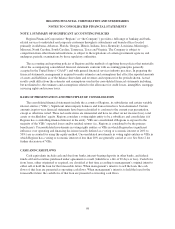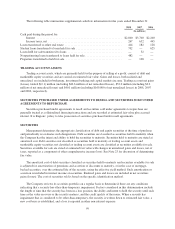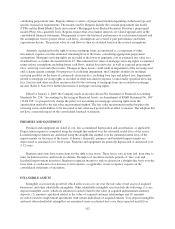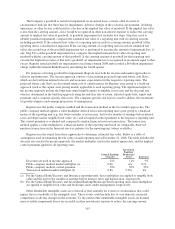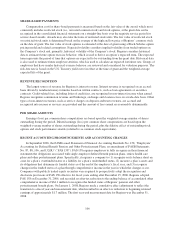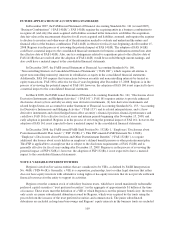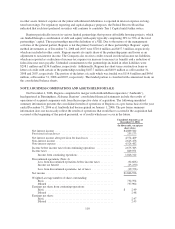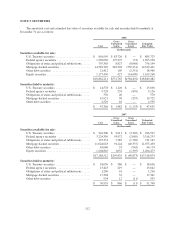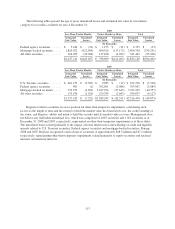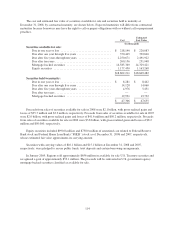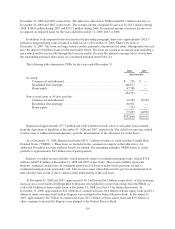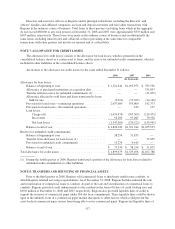Regions Bank 2008 Annual Report Download - page 117
Download and view the complete annual report
Please find page 117 of the 2008 Regions Bank annual report below. You can navigate through the pages in the report by either clicking on the pages listed below, or by using the keyword search tool below to find specific information within the annual report.In September 2006, the FASB ratified the consensus the Emerging Issues Task Force (“EITF”) reached
regarding EITF Issue No. 06-4, “Accounting for Deferred Compensation and Postretirement Benefit Aspects of
Endorsement Split-Dollar Life Insurance Arrangements” (“EITF 06-4”), which provides accounting guidance for
postretirement benefits related to endorsement split-dollar life insurance arrangements, whereby the employer
owns and controls the insurance policies. The consensus concludes that an employer should recognize a liability
for the postretirement benefit in accordance with Statement of Financial Accounting Standards No. 106,
“Employers’ Accounting for Postretirement Benefits Other Than Pensions” (“FAS 106”) or Accounting
Principles Board Opinion No. 12, “Omnibus Opinion – 1967” (“APB 12”). In addition, the consensus states that
an employer should also recognize an asset based on the substance of the arrangement with the employee. EITF
06-4 is effective for fiscal years beginning after December 15, 2007, with early application permitted.
In March 2007, the FASB ratified the consensus the EITF reached regarding EITF Issue No. 06-10,
“Accounting for Collateral Assignment Split-Dollar Life Insurance Arrangements” (“EITF 06-10”), which
provides accounting guidance for postretirement benefits related to collateral assignment split-dollar life
insurance arrangements, whereby the employee owns and controls the insurance policies. The consensus
concludes that an employer should recognize a liability for the postretirement benefit in accordance with FAS
106 or APB 12, as well as recognize an asset based on the substance of the arrangement with the employee. EITF
06-10 is effective for fiscal years beginning after December 15, 2007, with early application permitted. Regions
adopted EITF 06-4 and 06-10 on January 1, 2008, and the effect of adoption on the consolidated financial
statements was an after-tax reduction in retained earnings of approximately $15.5 million.
In September 2006, the FASB issued Statement of Financial Accounting Standards No. 157, “Fair Value
Measurements” (“FAS 157”), which provides guidance for using fair value to measure assets and liabilities, but
does not expand the use of fair value in any circumstance. FAS 157 also requires expanded disclosures about the
extent to which a company measures assets and liabilities at fair value, the information used to measure fair
value, and the effect of fair value measurements on an entity’s financial statements. This statement applies
whenever other standards require or permit assets and liabilities to be measured at fair value. FAS 157 is
effective for financial statements issued for fiscal years beginning after November 15, 2007, and interim periods
within those fiscal years, with early adoption permitted. Regions adopted FAS 157 on January 1, 2008, and the
effect of adoption on the consolidated financial statements was not material. Prospectively, Regions anticipates
the adoption of FAS 157 will impact the valuation of derivatives, specifically the credit component of the
valuation.
In February 2007, the FASB issued Statement of Financial Accounting Standards No. 159, “The Fair Value
Option for Financial Assets and Financial Liabilities” (“FAS 159”). FAS 159 allows entities to voluntarily
choose, at specified election dates, to measure financial assets and financial liabilities (as well as certain
non-financial instruments that are similar to financial instruments) at fair value (the “fair value option”). The
election is made on an instrument-by-instrument basis and is irrevocable. If the fair value option is elected for an
instrument, FAS 159 specifies that all subsequent changes in fair value for that instrument be reported in
earnings. FAS 159 is effective as of the beginning of an entity’s first fiscal year that begins after November 15,
2007, and earlier adoption is permitted. Regions adopted FAS 159 on January 1, 2008, for certain loans held for
sale originated on or after January 1, 2008, and there was no material effect of adoption on the consolidated
financial statements. Prospectively, Regions anticipates the adoption of FAS 159 will accelerate the timing of
gain recognition on loans held for sale.
In April 2007, the FASB issued FASB Staff Position FIN 39-1, “Amendment of FASB Interpretation
No. 39” (“FSP FIN 39-1”), which permits a reporting entity that is party to a master netting agreement to offset
fair value amounts recognized for rights and obligations relating to cash collateral against fair value amounts
recognized for derivative instruments that have been offset under the same master netting arrangements. FSP FIN
39-1 requires entities to make an accounting policy election to carry collateral posted/received at fair value,
netted against the corresponding derivative positions, or carry collateral posted/received presented separately at
cost. FSP FIN 39-1 is effective for fiscal years beginning after November 15, 2007, requiring retrospective
107



